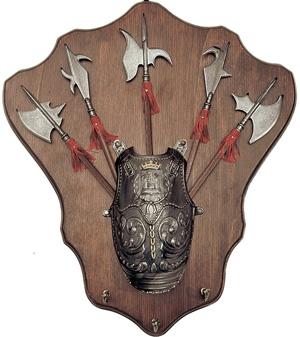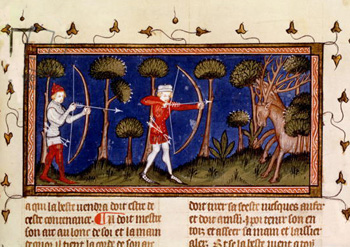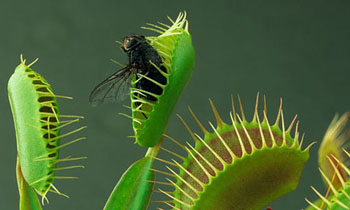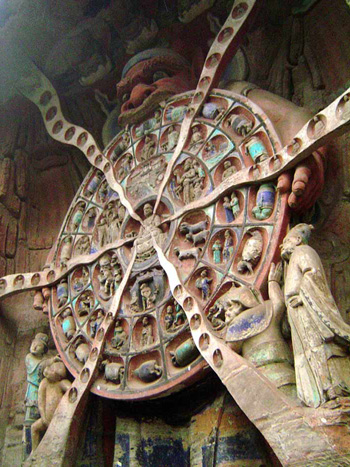There Is No Equality between Man & Animals
We will start to analyze today the recent Universal Declaration of Animal Rights by UNESCO (issued October 15, 1978, without the corrections made in 1989).
Toward this end, I first need to explain Catholic doctrine regarding life in the different kingdoms of creation. The Church explains that life results from an agent that is the principle of life existent in each being. This agent is connatural to the being: It is the human soul in men, the animal soul in the animals and the vegetable soul in the plants.
Scholasticism teaches that the soul is the principium vitae, the mysterious principle that confers life to the living being.
Human soul, animal soul & vegetable soul
There are three types of souls just as there are three ranks of beings. The highest, the human soul, is rational, it understands itself as well as external things.
 A man and an ox view a panoply differently
For example, regarding external things, if an ox and I were both to view a panoply of weapons like the one we have here, we would see the same thing. Probably the ox would see it better than I, because it does not use glasses, but it does not understand the panoply; it cannot grasp its meaning or its end. The ox has only a visual perception of the panoply, which it receives through its eyes.
A man and an ox view a panoply differently
For example, regarding external things, if an ox and I were both to view a panoply of weapons like the one we have here, we would see the same thing. Probably the ox would see it better than I, because it does not use glasses, but it does not understand the panoply; it cannot grasp its meaning or its end. The ox has only a visual perception of the panoply, which it receives through its eyes.
As for internal things, above all, the ox cannot know itself. I can say that I know that I exist, that I am not others and that others are not I. From his early childhood a man acquires the notion that he is an individual unit. This is perhaps the first the notion of “I” that comes to us. I am a closed circuit, as is each one of the others. This first notion of “I” is followed by another: that I am not the others. I am a person different from them. So, I conclude that I have interests, rights and duties that are different from those of the others.
This is how an intellectual being, whose soul is spiritual, acts. When a man dies, his soul is separated from his body, appears before God and is judged; then it goes to Heaven, Purgatory or Hell. This is what happens to a spiritual soul.
Now, the animal does not have a spiritual soul. Its vital principle is linked to matter, is co-identical to matter. It has knowledge of exterior things but it does not understand what it sees and it does not have knowledge of itself; it has no consciousness of what it is.
Next, there is the vegetable kingdom, in which each plant does not even have knowledge of the external world. Its vital principle is so limited that it only lives and does not have movement. Last on the scale are the minerals, which have no life at all.
Hierarchy in creation
By the order established by God, all these beings are good and were created in the image and likeness of God.
 A medieval hunting scene illustrates man's right to kill and eat animals
What is the difference between image and likeness? Roughly speaking it is like this: A son can be the image of his father because he is very similar to his father. However, when an artist chisels a work of art – for example, a pitcher – he imprints on his work an analogy with himself that is like him, his likeness. This does mean neither that the pitcher has the face of the artist nor that the artist has a face shaped like a pitcher; rather, there is a trait of the artist’s talent in the pitcher, which we call an analogy or likeness.
A medieval hunting scene illustrates man's right to kill and eat animals
What is the difference between image and likeness? Roughly speaking it is like this: A son can be the image of his father because he is very similar to his father. However, when an artist chisels a work of art – for example, a pitcher – he imprints on his work an analogy with himself that is like him, his likeness. This does mean neither that the pitcher has the face of the artist nor that the artist has a face shaped like a pitcher; rather, there is a trait of the artist’s talent in the pitcher, which we call an analogy or likeness.
We men are the sons who are similar to the Father; the animal is the pitcher analogous to the Artist.
God established as a principle that all the other beings should exist for the service of men. So, the animals and the plants exist for the service of men. Man, however, does not exist for the service of man. A man cannot kill another man or eat another man because each man was created directly for God. But man has the right to kill and eat the animal because the latter was created by God for man. The plant was created by God for the man and the animal.
 An exception to the rule: the Venus fly trap captures and feeds on insects
Man has the right to eat an ox and a plant. The ox also eats the plant – but not because he has rights. A being that does not have a spiritual soul has no rights. An ox eats a plant because it is according to nature for it to do so. It is much rarer that a plant eats an animal, although some cases exist.
An exception to the rule: the Venus fly trap captures and feeds on insects
Man has the right to eat an ox and a plant. The ox also eats the plant – but not because he has rights. A being that does not have a spiritual soul has no rights. An ox eats a plant because it is according to nature for it to do so. It is much rarer that a plant eats an animal, although some cases exist.
For example, there are some plants, like the Venus fly trap, that catch insects that pass with a trapping structure in its leaves. The fly remains in that green prison until it deteriorates and its matter is assimilated by the plant. We can say, therefore, that the plant ate the insect, it assimilated the animal. But this is an exception in nature. The order established by God is that the superior being, which is the animal, should be served by the inferior being, which is the plant and, thus, the animal can eat the plant.
Consequently, to affirm that there is equality among men, animals and plants is to deny the superiority of man, the role of the spiritual soul in man, which gives him rights over the animals. To affirm this equality is to deny the spirituality of the soul. Since anyone who denies the human soul denies God, this is tantamount to make a profession of faith in materialism. Or, better said, it is an affirmation of non-faith, of atheism, because atheism is not a faith.
The doctrines of metempsychosis
There are religious doctrines, such as metempsychosis, that deny what the Church teaches. They believe in the transmigration of the soul, the reincarnation of souls after death. The religion of Brahmanism, for example, affirms that man was created by god and when he follows the correct path on earth and dies, he is integrated into that god.
 The Buddhist wheel in the Dazu grotto summarizes the endless cycle of reincarnations
But its god is a kind of vague ethereal cloud, not a person. The soul of the dead man enters it and expands agreeably, like a sort of smoke. Imagine in a church the smoke that comes from the grains of incense in contact with the blazing charcoal. The resulting smoke, following the principle of the dilation of gases, expands and mixes with the air in the church; after a while it is incorporated into the air of the church.
The Buddhist wheel in the Dazu grotto summarizes the endless cycle of reincarnations
But its god is a kind of vague ethereal cloud, not a person. The soul of the dead man enters it and expands agreeably, like a sort of smoke. Imagine in a church the smoke that comes from the grains of incense in contact with the blazing charcoal. The resulting smoke, following the principle of the dilation of gases, expands and mixes with the air in the church; after a while it is incorporated into the air of the church.
This gives us an idea of how a Brahmanist understands the final end of man. God would be like this air and man would be like the smoke that dissolves in that air without knowing or feeling anything. The Brahmanists consider knowing and feeling to be evil. According to them, man is unhappy because he knows and feels. What is good is to annihilate the self and escape individualism, which makes him suffer.
When a man is bad on this earth, he dies and becomes an animal; if he is very bad, he becomes a plant. Then, if he does well as a plant in the new cycle, he is raised up to be an animal; finally, he becomes man again and has another chance to become god. This doctrine comports the idea that many persons remain in this cycle perpetually and that it is very difficult to escape it and be fused into the divinity.
These doctrines are contrary to Catholic doctrine and condemned by the Church.
Note: These comments were made on November 8, 1978, shortly after the UNESCO issued its first declaration. The text available in 2017 suffered several editings, which are not addressed in this series.
Toward this end, I first need to explain Catholic doctrine regarding life in the different kingdoms of creation. The Church explains that life results from an agent that is the principle of life existent in each being. This agent is connatural to the being: It is the human soul in men, the animal soul in the animals and the vegetable soul in the plants.
Scholasticism teaches that the soul is the principium vitae, the mysterious principle that confers life to the living being.
Human soul, animal soul & vegetable soul
There are three types of souls just as there are three ranks of beings. The highest, the human soul, is rational, it understands itself as well as external things.
 A man and an ox view a panoply differently
A man and an ox view a panoply differentlyAs for internal things, above all, the ox cannot know itself. I can say that I know that I exist, that I am not others and that others are not I. From his early childhood a man acquires the notion that he is an individual unit. This is perhaps the first the notion of “I” that comes to us. I am a closed circuit, as is each one of the others. This first notion of “I” is followed by another: that I am not the others. I am a person different from them. So, I conclude that I have interests, rights and duties that are different from those of the others.
This is how an intellectual being, whose soul is spiritual, acts. When a man dies, his soul is separated from his body, appears before God and is judged; then it goes to Heaven, Purgatory or Hell. This is what happens to a spiritual soul.
Now, the animal does not have a spiritual soul. Its vital principle is linked to matter, is co-identical to matter. It has knowledge of exterior things but it does not understand what it sees and it does not have knowledge of itself; it has no consciousness of what it is.
Next, there is the vegetable kingdom, in which each plant does not even have knowledge of the external world. Its vital principle is so limited that it only lives and does not have movement. Last on the scale are the minerals, which have no life at all.
Hierarchy in creation
By the order established by God, all these beings are good and were created in the image and likeness of God.
 A medieval hunting scene illustrates man's right to kill and eat animals
A medieval hunting scene illustrates man's right to kill and eat animalsWe men are the sons who are similar to the Father; the animal is the pitcher analogous to the Artist.
God established as a principle that all the other beings should exist for the service of men. So, the animals and the plants exist for the service of men. Man, however, does not exist for the service of man. A man cannot kill another man or eat another man because each man was created directly for God. But man has the right to kill and eat the animal because the latter was created by God for man. The plant was created by God for the man and the animal.
 An exception to the rule: the Venus fly trap captures and feeds on insects
An exception to the rule: the Venus fly trap captures and feeds on insectsFor example, there are some plants, like the Venus fly trap, that catch insects that pass with a trapping structure in its leaves. The fly remains in that green prison until it deteriorates and its matter is assimilated by the plant. We can say, therefore, that the plant ate the insect, it assimilated the animal. But this is an exception in nature. The order established by God is that the superior being, which is the animal, should be served by the inferior being, which is the plant and, thus, the animal can eat the plant.
Consequently, to affirm that there is equality among men, animals and plants is to deny the superiority of man, the role of the spiritual soul in man, which gives him rights over the animals. To affirm this equality is to deny the spirituality of the soul. Since anyone who denies the human soul denies God, this is tantamount to make a profession of faith in materialism. Or, better said, it is an affirmation of non-faith, of atheism, because atheism is not a faith.
The doctrines of metempsychosis
There are religious doctrines, such as metempsychosis, that deny what the Church teaches. They believe in the transmigration of the soul, the reincarnation of souls after death. The religion of Brahmanism, for example, affirms that man was created by god and when he follows the correct path on earth and dies, he is integrated into that god.
 The Buddhist wheel in the Dazu grotto summarizes the endless cycle of reincarnations
The Buddhist wheel in the Dazu grotto summarizes the endless cycle of reincarnationsThis gives us an idea of how a Brahmanist understands the final end of man. God would be like this air and man would be like the smoke that dissolves in that air without knowing or feeling anything. The Brahmanists consider knowing and feeling to be evil. According to them, man is unhappy because he knows and feels. What is good is to annihilate the self and escape individualism, which makes him suffer.
When a man is bad on this earth, he dies and becomes an animal; if he is very bad, he becomes a plant. Then, if he does well as a plant in the new cycle, he is raised up to be an animal; finally, he becomes man again and has another chance to become god. This doctrine comports the idea that many persons remain in this cycle perpetually and that it is very difficult to escape it and be fused into the divinity.
These doctrines are contrary to Catholic doctrine and condemned by the Church.
Note: These comments were made on November 8, 1978, shortly after the UNESCO issued its first declaration. The text available in 2017 suffered several editings, which are not addressed in this series.
